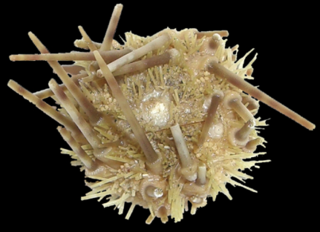
The Camarodonta are an order of globular sea urchins in the class Echinoidea. The fossil record shows that camarodonts have been in existence since the Lower Cretaceous.
Abatus curvidens is a species of sea urchin of the family Schizasteridae. Their armour is covered with spines. It came from the genus Abatus and lives in the sea. Abatus curvidens was first scientifically described in 1836 by Ole Mortensen.
Amphipneustes similis is a species of sea urchin of the family Temnopleuridae. Their armour is covered with spines. It is placed in the genus Amphipneustes and lives in the sea. Amphipneustes similis was first scientifically described in 1936 by Ole Mortensen, Danish zoologist.
Antrechinus mortenseni is a species of sea urchin of the family Urechinidae. Their armour is covered with spines. It is placed in the genus Antrechinus and lives in the sea. Antrechinus mortenseni was first scientifically described in 1990 by David & Mooi.
Breynia elegans is a species of sea urchins of the Family Loveniidae. Their armour is covered with spines. Breynia elegans was first scientifically described in 1948 by Ole Theodor Jensen Mortensen.
Brissopsis persica is a species of sea urchins of the Family Brissidae. Their armour is covered with spines. Brissopsis persica was first scientifically described in 1940 by Ole Theodor Jensen Mortensen.
Caenopedina alanbakeri is a species of sea urchins of the Family Pedinidae. Their armour is covered with spines. Caenopedina alanbakeri was first scientifically described in 1989 by Rowe.
Caenopedina capensis is a species of sea urchins of the Family Pedinidae. Their armour is covered with spines. Caenopedina capensis was first scientifically described in 1923 by Hubert Lyman Clark.
Caenopedina cubensis is a species of sea urchins of the Family Pedinidae. Their armor is covered with spines. Caenopedina cubensis was first scientifically described in 1869 by Alexander Emanuel Agassiz.
Caenopedina depressa is a species of sea urchins of the Family Pedinidae. Their armour is covered with spines. Caenopedina depressa was first scientifically described in 1927 by Koehler.

Caenopedina hawaiiensis is a species of sea urchins of the Family Pedinidae. Their armor is covered with spines. Caenopedina hawaiiensis was first scientifically described in 1912 by Hubert Lyman Clark.
Caenopedina indica is a species of sea urchins of the Family Pedinidae. Their armour is covered with spines. Caenopedina indica was first scientifically described in 1903 by de Meijere.

Caenopedina mirabilis is a species of sea urchins of the Family Pedinidae. Their armour is covered with spines. Caenopedina mirabilis was first scientifically described in 1885 by Döderlein.
Caenopedina otagoensis is a species of sea urchins of the Family Pedinidae. Their armour is covered with spines. Caenopedina otagoensis was first scientifically described in 1968 by McKnight.
Caenopedina porphyrogigas is a species of sea urchins of the Family Pedinidae. Their armour is covered with spines. Caenopedina porphyrogigas was first scientifically described in 2009 by Anderson.
Caenopedina pulchella is a species of sea urchins of the family Pedinidae. Their armour is covered with spines. Caenopedina pulchella was first scientifically described in 1907 by Alexander Emanuel Agassiz and Hubert Lyman Clark.
Caenopedina superba is a species of sea urchins of the family Pedinidae. Their armour is covered with spines. Caenopedina superba was first scientifically described in 1925 by Hubert Lyman Clark.
Calocidaris micans is a species of sea urchins of the Family Cidaridae. Their armour is covered with spines. Calocidaris micans was first scientifically described in 1903 by Ole Mortensen.

Chaetodiadema is a genus of sea urchins of the Family Diadematidae. Their armour is covered with spines.

The Echinothuriidae are a family of sea urchins in the order Echinothurioida. Due to their soft skeletons, most are called "leather urchins", but species in the genus Asthenosoma are also known as "fire urchins" due to their bright colors and painful, venomous sting.






